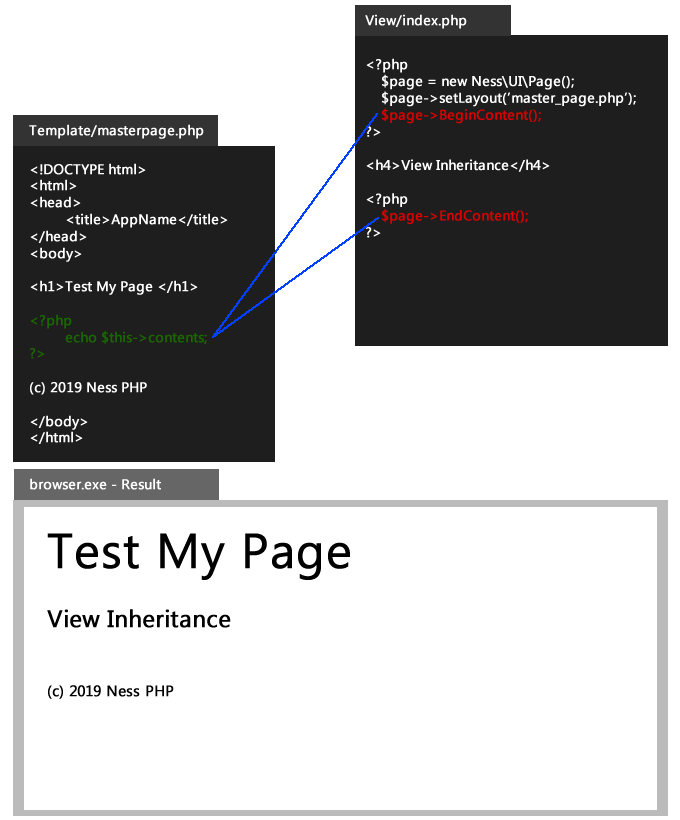- Ness
- UI
- Page
- UI
You can include this library to your code file by typing the below code;
use Ness\UI\Page
About Ness PHP's Template Engine #top
Ness PHP's master pages allows you to create layouts for your web pages in your application.It is designed to eliminate the need to write the same html code for each repetitive design every time.Once you design a template, you can easily relate it to all the pages and accelerate your coding experience to twice that. This topic can be thought of as the continuation of the 'View' topic you can read more about views Here
Create New Master Page #top
You can create unlimited master pages for your application for using them later with view files. All your master pages should be located in 'Template' directory which can be found in Application root. For example you can create two master pages one for backend(admin panel) and one for front-end (user-area) and switch between them while creating new views using the master pages you have created.
Here is a simple example for a Master Page definition. Save this file as adminpanel_master.php in Template directory.
<!DOCTYPE html>
<html>
<head>
<title>{@page_title} - Simple Blog</title>
<link rel="stylesheet" type="text/css" href="<?= Ness\ContentManager::getStyleSheet("style.css");?>">
</head>
<body>
<div class="menu">
<ul>
<li>
<a href="#">Dashboard</a>
<a href="#">Profile</a>
<a href="#">Create User</a>
<a href="#">Edit Posts</a>
<li>
</ul>
<?php
/**
* This line below must me available in all your master pages.
* echo $this->contents; means your content place holder. Your data in
* views will be loaded here.
*/
echo $this->contents;
?>
<div class="footer">
<h4>(C) Ness Tutorials - Sinan SALIH </h4>
</body>
</html>
As you can realise there is basic design for our admin panel with menu, footer and a code line like; echo $this->contents; this code snippet is required for the inheritance. When you create a new sub-view from the template all codes (HTML+PHP) in your View/viewfile.php will be parsed and placed in the line where $this->contents is printed.
Template Inheritance #top
Using templates in Ness PHP is extremely easy. Just create a new view file and specify the master page you have created.
<?php
$page = new Ness\UI\Page();
$page->setLayout('adminpanel_master.php');
$page->BeginContent();
?>
<!-- PAGE CONTENT STARTS -->
<!-- YOUR HTML/PAGE CONTENTS FOR THIS PAGE -->
<!-- PAGE CONTENT ENDS -->
<?php
$page->EndContent();
?>
As you can use we are using adminpanel_master.php template file. All contents between $page->BeginContent();$page->EndContent();echo $this->contents;How Template Engine Works #top

Template Engine Language #top
If you want to use template engine, you need to follow some rules. Some of them are like the ones below
-
Content Place Holder Please do not forget to define and print
$this->contentsvariable where you want to put your view's html contents. -
Define Parameters If you want to set parameters between layouts and views, you need to type
{@parameter1}in your layout file. You can set a value for your parameters by typing$view_variable->SetParameter("parameter1", "my value is.."); -
Page Title You can set a different title for every view. You can complete this task by setting a parameter but also if you type
echo $this->title;on your template file you can use and set a title by SetTitle command
Methods #top
SetLayout
$view->SetLayout(string $prm_file);| Use a template file in your views with this command | ||
| Return | Void | |
| Parameters | $prm_file String; File name of master page | |
SetParameter
$view::SetParameter(string $prm_name,string $prm_value );| Set content for parameter defined in template page. | ||
| Return | Void | |
| Parameters | $prm_name String; Parameter name available in template $prm_value String; Value to set for the parameter |
|
SetParameterNull
$view->SetParameterNull(string $prm);| Set null value to unused parameter in template files | ||
| Return | Void | |
| Parameters | $prm String; Parameter name | |
SetTitle
if you do not use parameters for setting title you can use this function. Remember <?php echo $this->title; ?> must be defined in template.$view->SetTitle(string $title);| Set a title for an inheritanced view | ||
| Return | Void | |
| Parameters | $title String; Title set for the page | |
insertWidget
Page::insertWidget(string $prm);| Include a widget from Application/Content/widget path | ||
| Return | Object | |
| Parameters | $prm String; File name; ex: widget.html | |
BeginContent() & EndContent()
Start and Finish content definitions for view files when using a template.
$view->BeginContent();
...
..
.
Contents Here
.
..
...
$view->EndContent();